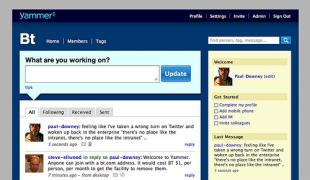OpenSesame is using Yammer. I confess that I didn’t think we needed a tech solution to communication and collaboration. After all, we’re a relatively small and very collaborative team. When I have a question, I say it out loud and someone answers me. But we are strong believers in understanding emerging technologies by using them. Clearly, social learning is an emerging technology: So we decided to test-drive Yammer for starters. We like it a lot.
For the uninitiated, Yammer looks, acts and feels like Facebook, but is built within a separate domain for your workplace. Yammer enables media sharing, conversation and collaborative discussion with an easy-to-use interface. Unlike Facebook, it is a private and paid service.
How We Use the Social Workplace
 The OpenSesame crew engages in diverse discussions in our Yammer network, including articles about emerging technologies, blog posts from other organizations in our field, status updates about what we’ve been working on and also silly YouTube videos.
The OpenSesame crew engages in diverse discussions in our Yammer network, including articles about emerging technologies, blog posts from other organizations in our field, status updates about what we’ve been working on and also silly YouTube videos.
Our posts inspire conversations, brainstorming and ideas. “Our customer X is interested in Z feature. What do you guys think?” might inspire “Yeah, that’s a great idea; let’s put that in the queue for next month.” Or, possibly, “I don’t think we should do that because XYZ. Instead, let’s try Y.”
These honest discussions are tremendously valuable, but the subtle benefits are possibly even more important. The social discussion makes the everyday collaboration within our team more fun. I find myself checking my Yammer news feed on my phone after hours just like I check my Facebook updates. Even when we’re just sharing Conan Wears Jeggings videos, the conversation builds connections and relationships between coworkers. I can imagine that this would be tremendously valuable for organizations with hundreds or thousands of employees spread across multiple locations.
It’s easy to fire off a quick Yammer post. It makes constant presence and participation possible, but it does not require an immediate response. This ensures that conversation can occur between 10 people without interrupting 10 people’s work flows. Colleagues can participate when they are shifting gears between projects or specifically when they have set aside time to do so, but they don’t need to go to a meeting or answer a phone call.
For a manager, Yammer provides further insights into employee performance. What do employees do all day? How do they approach their work? What are they worried about? Yammer also gives a manager simple and informal opportunities to provide feedback and input without micro-managing.
The Social OS is the Future

Yammer offers an API and a range of existing apps and integrations, including a SharePoint extension. Integrating a social application or feature in a traditional LMS creates opportunitites to house collaborative conversation within your existing learning systems. Without a doubt, enterprising LMS developers worldwide should and will use the Yammer API to build extensions for their browser-based LMSs.
But that’s just scratching the surface. The next generation of social applications will integrate collaborative conversations throughout existing workplace systems. For example, what if your organization used a Yammer web browser? It would work like Rockmelt, but enable colleagues to share and discuss what they’re working on without leaving the browser interface.
Even better, what if your OS offered a social extension? The social OS would build sharing and discussion into everything we do in the workplace, from working in web browsers and browser-based applications to communicating with customers. Collaborative conversation would be part of the work plan, accessible from every angle, and not a separate step for employees to complete. This is the holy grail
Ultimately, social workplaces make organizations more productive and efficient by creating organic opportunities to think up new ideas and identify best practices. After all, two brains are almost always better than one.
Photo Credit: FreeFoto.com






